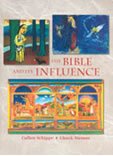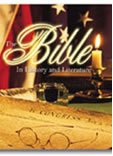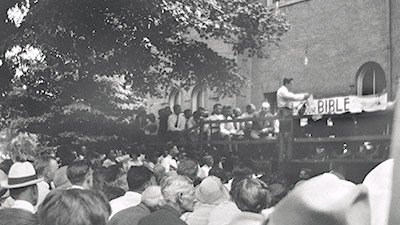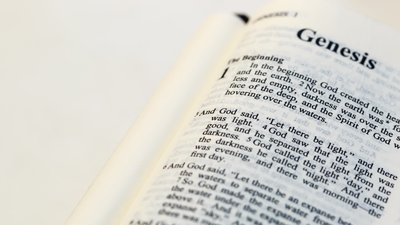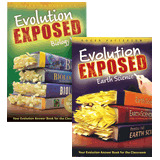
Teaching the Bible in Public Schools: A Review of Two Textbooks
In the Time magazine cover article (March 22, 2007), “The Case for Teaching the Bible,” author David Van Biema argues for teaching the Bible in public schools.
In his article, he mentions two textbooks that are currently being used in US public schools: The Bible in History and Literature, published by the National Council on Bible Curriculum in the Public Schools, and The Bible and Its Influence, published by the Bible Literacy Project. We reviewed both texts and offer this summary analysis.
The Bible and Its Influence © 2006 (www.bibleliteracy.org)
The Bible and Its Influence is an attractive book with many colorful illustrations and reproductions of religious art. Each unit covers one or more books of the Bible and offers historical background, theological insights, and explanation of the text.
Throughout the textbook are special features, such as “Cultural Connections,” “Historical Connections,” and “The Bible in Literature.” It takes the student through the Old and New Testaments, covering many of the major biblical themes and personalities.
The Teacher’s Edition offers lesson objectives, biblical information, discussion questions, vocabulary, and review questions.
There are 14 units in the curriculum:
Unit 1: Introductions
Unit 2: Genesis—Origins
Unit 3: Genesis—Call and Promise
Unit 4: Exodus and the Land of Promise
Unit 5: Kingdom and Exile
Unit 6: The Prophets
Unit 7: Writings and Wisdom
Unit 8: Another Covenant
Unit 9: The Four Gospels
Unit 10: The Early Christian Community
Unit 11: The Letters of Paul
Unit 12: Other Letters
Unit 13: Revelation
Unit 14: Epilogue
While this text is impressive in its scope and look, its approach to Scripture is a bit alarming. There are numerous instances where the text of the Bible is denigrated, the authorship of the Bible is questioned, the historical accuracy of the Scriptures is denied, and outright mistakes are made. I will list several cases of these below.
| Textbook Quote (TE=Teacher Edition) |
Comment |
|---|---|
p. 16: “The writers, editors, and compilers of the Bible had quite a different view of dates and of history. …be careful not to apply contemporary standards of history, dating, or the sequencing of events to what you read.” |
Casts doubt on the integrity of the text of the Bible by insinuating that it has undergone significant editing and compiling over the centuries. Gives the impression that the history and dating of the biblical accounts are not accurate. |
p.30TE: “The text [Genesis 1] shows a God creating order where there was chaos.” |
God created the universe out of nothing, not out of chaos. |
p. 40TE: “Students may wonder where Cain found a wife, if his was the first human family; the Book of Genesis does not concern itself with this incongruity.” |
No answer is given for this question—rather it is called an “incongruity.” See our topic page on Cain for the answer. |
p. 51: “Once again (as in the account of the great flood), God lost patience with the wickedness of humans and determined to destroy the cities of the plain and start fresh.” |
Says that God “lost patience,” which confers human weakness on God. |
p. 54: “Why are dreams (both waking and sleeping ones) important for self-understanding?” |
Gets into psychology. What does this have to do with the influence of the Bible in art and literature? |
p. 64TE: “Exodus describes … the events that occurred as the people wandered in the wilderness for several generations before returning to the Promised Land.” |
Factual error—the Israelites wandered for 40 years, which was one generation, not several (see Num. 32:13). |
p. 73: “When he came down from the mountain, Moses was forever changed; the skin of his face glowed with rays of light so stunning that he thereafter has to wear a veil when speaking with humans.” |
The OT states that Moses spoke to the Israelites without the veil, and then placed it over his face after he was done speaking with them (Exo. 34:29–35 ). The NT states that he wore the veil to hide the fact that the glow was fading (2 Cor. 3:13). |
p. 117: “You’ve probably seen cartoon or movie depiction of the prophet of doom, a shaggy-bearded individual in ragged robes, ranting from a soapbox or wearing a sandwich board sign that reads, ‘The end is near.’” |
This slur denigrates the “holy prophets of old” and builds a negative image in the reader. |
p. 156: “Discover … the arguments for and against a good God who lets bad things happen.” |
Puts God “on trial” and let’s the reader decide what is good and evil and if God is just or not. |
p. 156TE: “How an all-powerful and just God can allow innocent people to suffer.” |
The Bible makes it clear that no one is innocent (Psalm 14; Rom. 3) |
p. 160TE: “Leviathan and Behemoth might be legendary beasts, or they could be fanciful descriptions of known animals (whale or giant squid for Leviathan; rhinoceros, hippopotamus, or elephant for Behemoth.” |
Treats the descriptions in Job (by God) as fanciful and not literal. None of these proposed animals fit the description, but dinosaurs do. |
p. 167: “According to Christian tradition, Ruth was an ancestor of Jesus.” |
Ignores clear biblical teaching and casts doubt on the NT. The NT states that Ruth was an ancestor of Jesus (Matt. 1:5); this is not by “Christian tradition.” |
p. 181: “The device of having an angelic guide act as a mediator and interpreter of vision was common to the apocalyptic literature of the Jewish, Christian, and Islamic traditions.” |
Casts doubt on the truth of Scripture and the existence of angels. Angels are said to be just a literary device. |
p. 211: “In many ways, the gospels are proclamations of the early church. They describe the life and teaching of Jesus as seen through the eyes of faith—as the life and teaching had come to be understood in the community … You are not picking up a newspaper account or even a memoir. |
Teaches that the gospels are not an accurate account of the life and teaching of Jesus. States that the gospels are a “faith-filled look at Jesus.” Casts doubt on the authenticity of the gospels. |
p. 219: “The Gospel of Mark begins like classical epics—such as The Iliad and The Odyssey—in the middle of the action.” |
Equates the Gospel of Mark to Greek mythology and fiction. |
p. 232: “Finally, the mention of the Father, the Son, and the Holy Spirit is a demonstration that the foundational Christian doctrine of the trinity was a part of the community’s faith by the time this gospel [Matthew] was written.” |
Ascribes the words of Jesus in the Great Commission (Matt. 28:18–20) as an inclusion by the later church that demonstrates their belief in the Trinity. |
p. 238: “Luke used a travel motif for his account with the overall theme of a journey from Jesus’ birth in an inconsequential town of Nazareth to his death in the capital Jerusalem.” |
Factual error—Jesus was not born in Nazareth, but in Bethlehem. Also, calls Luke’s gospel account a “travel motif” and “theme of a journey,” discrediting its historical integrity. |
p. 257: “[Acts] 9:36–43, where Peter reportedly brought Tabitha back to life.” |
Casts doubt on the historical veracity of the book of Acts. The text clearly states that Tabitha died. |
p. 298: “This term, which in the original Greek is kenosis (emptying), has been interpreted by Christians as describing Jesus, whom they thought to be God, humbling himself to become a human being.” |
This statement invalidates the clear teaching of the NT that Jesus is God. States that early Christians only “thought” Jesus to be God. |
The Bible and Its Influence tries to take a “scholarly” approach, but aligns itself more with “modern” biblical scholarship than traditional conservative scholarship. In fact, in the Teacher’s Edition, teachers are told, “The teacher of this course needs to show respect for the discipline of biblical scholarship and biblical criticism” (p. T13). Clearly they are referring to modern, liberal scholarship.
While a student with not much previous exposure to the Bible may learn some interesting things about the Bible and some of the Bible stories, the whole tone of the book would most likely lead them to believe that the Bible is a collection of man-made stories, handed down over generations, that merely reflects the faith tradition of Jews and Christians. There are no apologetic arguments or even statements showing the accuracy of the Bible in history, archaeology, etc.
This textbook goes beyond its stated goal: “To give a basic knowledge of this great sourcebook [the Bible] and to demonstrate its influence on other works of culture, on development of language, and on historical perspective.” Instead of sticking with the facts, The Bible and Its Influence engages the student in psychology, values clarification, theological discussions, critique of social movements, etc. It seems to promote a progressive, liberal agenda and, as shown above, has several factual errors and does not depict the Bible as an historically accurate document.
The Bible in History and Literature © 2007 (www.bibleinschools.net)
The Bible in History and Literature takes a much more straight-forward approach to a study of the Bible in public schools. Unlike The Bible and Its Influence, which often touches on areas outside of the Bible, the approach of the National Council on Bible Curriculum in Public Schools is to stick with the text and treat the Bible as a reliable historical document. Rather than a large textbook with lengthy articles that refer to the Bible, this curriculum uses the Bible as the main textbook for the course. The student book is called a “curriculum guide,” and includes book outlines, discussion questions, quizzes, worksheets, and optional activities.
Each unit covers a section of the Bible, from just a few chapters to several books at a time.
Each unit includes objectives, lesson plans, and student activities. Other features include historical overviews, archaeological discoveries, charts & tables, as well as worksheets, quizzes, and tests.
There are 18 units in the curriculum:
Unit 1: Introduction to Bible Study
Unit 2: Genesis Chapters 1–25
Unit 3: Isaac, Jacob and Joseph (Genesis 25–50)
Unit 4: Moses in Egypt
Unit 5: The Passover
Unit 6: Hebrew Law
Unit 7: Becoming a People: Law, Customs & Holidays
Unit 8: Deuteronomy, Joshua & Judges
Unit 9: Literature Highlights
Unit 10: The Kings & Prophets
Unit 11: The Dead Sea Scrolls & Other Archeological Finds
Unit 12: The Inter-Testamental Period & Chanukah
Unit 13: Introduction to the New Testament (B'rit Chadasha)
Unit 14: The Four Gospels
Unit 15: The Final Week
Unit 16: The Acts of the Apostles & The Beginning of the Church
Unit 17: The Bible in History
Unit 18: Biblical Art
What this curriculum lacks in color and illustrations, it makes up for in its adherence to the biblical text and its uncomplicated treatment of the Bible as an essentially dependable historical record. It covers the Bible’s influence on art and literature, and its influence on America’s founding fathers, but steers clear of psychology and social movements. Its goal is to familiarize students with the text of the Bible and it does that well.
The Bible in History and Literature curriculum includes a Teacher’s Companion Guide with objectives, answers to worksheets and tests, and additional information for the teacher.
Also included with the student textbook is a CD-ROM containing the complete text of the book, The Bible Reader: An Interfaith Interpretation.”
1
Some areas of improvement needed in this otherwise fine curriculum include the following:
- Having lecture notes/introductions for every unit (some have them, some don’t)
- Adding more illustrations for student interest, where appropriate.
Conclusion
We are glad to see that organizations are getting the Bible back into the public schools to help students become aware of its influence on society, history, art, and literature. While The Bible and Its Influence is colorful and well-organized, its approach to the Bible as outlined above would keep us from recommending it.
The Bible in History and Literature is a step in the right direction. Here is a textbook that will give public school students who are not familiar with the Bible a good grasp on the biblical accounts from creation to the early church, and help them see the impact the Bible has had on art, literature, and society. We hope that the few improvements noted above are made in subsequent printings to help make this good curriculum even better.
Footnotes
- This 995-page volume was published in 1969. Written by four authors (a Roman Catholic priest, a rabbi, and two Protestant scholars), it contains extensive selections from both Old and New Testaments. It also includes commentary that provides a cultural understanding of the Bible. In addition, disputed texts are fully and carefully interpreted, explaining the basic Jewish, Protestant, and Catholic viewpoints. The Bible Reader also abounds with references to music, art, and literature that reflect biblical themes.
Recommended Resources

Answers in Genesis is an apologetics ministry, dedicated to helping Christians defend their faith and proclaim the good news of Jesus Christ.
- Customer Service 800.778.3390
- © 2024 Answers in Genesis

